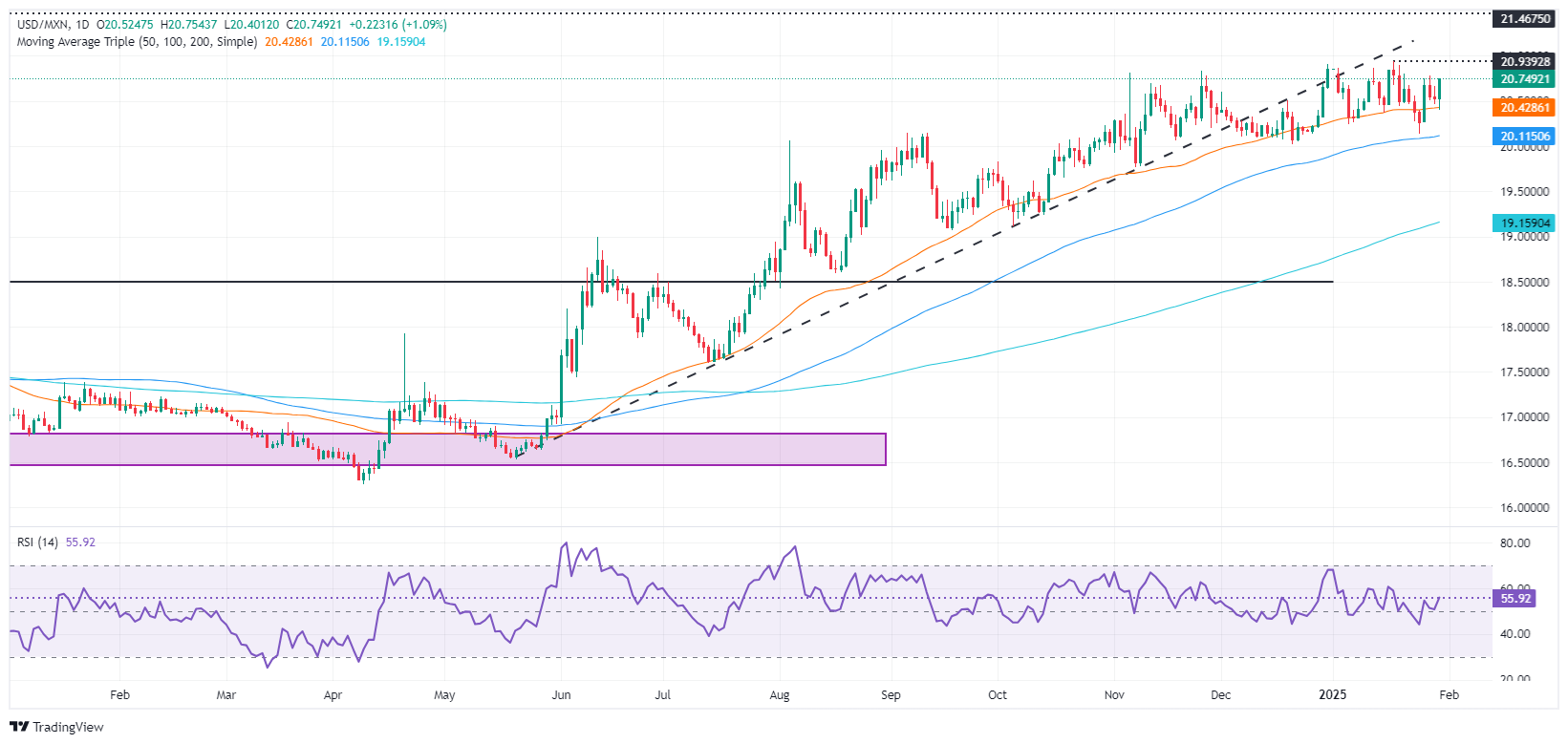- The Mexican Peso plummets on Trump’s threatening to impose 25% tariffs on Mexico.
- Banxico is expected to cut rates to stimulate the economic recovery amid global uncertainties.
- Monetary policy divergence between Fed and Banxico, plus US tariff threats, to boost USD/MXN.
The Mexican Peso (MXN) erased its earlier gain after US President Donald Trump stated that he would impose 25% tariffs on Canada and Mexico due to Fentanyl. The USD/MXN trades at 20.74, up 1.17%.
According to Reuters, Trump’s trade rhetoric continued. He added that on Thursday night, he will probably decide to impose tariffs on Oil from Canada and Mexico.
After the headlines, the USD/MXN spiked above 20.70 and hit a daily high of 20.74. Since then, the exotic pair has stabilized.
In the meantime, the Gross Domestic Product (GDP) in Mexico contracted quarterly, justifying the latest actions taken by the Banco de Mexico (Banxico), which lowered rates by 25 basis points (bps) at the December meeting.
Although it would be tempting for Banxico to increase the size of easing from 25 to 50 bps, potential US tariffs imposed on Mexico and Canada could impact the economy, exerting pressure on the Mexican Peso.
Across the north of the border, US GDP for the fourth quarter missed forecasts, while the number of Americans filling for unemployment claims hinted the labor market remains solid, according to the US Department of Labor.
Given the backdrop, the USD/MXN pair extended its losses beneath the crucial 20.50 figure. However, the central bank divergence between the Federal Reserve (Fed) and Banxico suggests the exotic pair is poised for higher prices.
Toward the end of the week, the US economic docket will feature the release of the Fed’s favorite inflation gauge, the Personal Consumption Expenditures (PCE) Price Index, and Fed speakers. Regarding Mexico, the schedule is empty, but traders will await the release of Foreign Reserves on February 3.
Daily digest market movers: Mexico’s economic slowdown to weigh on Mexican Peso
- INEGI announced that Q4 2024 GDP shrank by -0.6% QoQ, more than the -0.2% contraction expected by economists and down from Q3 1.1% expansion. On a yearly comparison, GDP rose 0.6%, beneath forecasts for a 1.2% growth rate, its lowest rate since Q1 2021.
- The data supports Banxico’s dovish stance. The Mexican institution is expected to lower rates at least by 25 bps from 10% to 9.75%, though analysts from Capital Economics suggest that 50 bps of easing are on the table.
- Banxico Deputy Governor Omar Mejia Castelazo was dovish on Wednesday and said that Banxico has enough room to maneuver and calibrate monetary policy at upcoming monetary policy meetings.
- The US Department of Commerce revealed that Q4 GDP dipped from 3.1% to 2.3%, missing investors' estimates of 2.6%.
- Meanwhile, the US Department of Labor revealed that Initial Jobless Claims for the week ending January 24 increased by 207K, beneath forecasts of 220K and the previous week 223K.
- On Wednesday, the Fed kept rates unchanged at 4.25% - 4.50% on a unanimous vote, justifying their decision due to the strength of the US economy, the lack of progress on lowering inflation, and a recovery of the jobs market.
- Fed Chair Jerome Powell said the US central bank is in no rush to ease policy, reassuring that they don’t have a pre-set path regarding monetary policy.
- Money market futures have priced in 50 bps of Fed rate cuts in 2025, according to CME FedWatch Tool data.
USD/MXN technical outlook: Mexican Peso appreciates but is still poised to weaken to 20.50
The USD/MXN uptrend remains intact, although sellers pushed prices toward the 50-day Simple Moving Average at 20.39 but could not crack that area, opening the door for a recovery.
Although momentum shifted bearish, as depicted by the Relative Strength Index (RSI), bears need to clear the 50-day SMA and the January 24 swing low of 20.12. A breach of the latter could send the USD/MXN tumbling towards 20.00 and below.
Conversely, bulls seeking a recovery need to lift the exchange rate above 20.50 and challenge the January 29 high at 20.66, forming a ‘bullish engulfing’ chart pattern.
In that outcome, the USD/MXN's next resistance would be the year-to-date (YTD) high of 20.90, which is ahead of 21.00.
Source: Tradingview - FXStreet
Mexican Peso FAQs
The Mexican Peso (MXN) is the most traded currency among its Latin American peers. Its value is broadly determined by the performance of the Mexican economy, the country’s central bank’s policy, the amount of foreign investment in the country and even the levels of remittances sent by Mexicans who live abroad, particularly in the United States. Geopolitical trends can also move MXN: for example, the process of nearshoring – or the decision by some firms to relocate manufacturing capacity and supply chains closer to their home countries – is also seen as a catalyst for the Mexican currency as the country is considered a key manufacturing hub in the American continent. Another catalyst for MXN is Oil prices as Mexico is a key exporter of the commodity.
The main objective of Mexico’s central bank, also known as Banxico, is to maintain inflation at low and stable levels (at or close to its target of 3%, the midpoint in a tolerance band of between 2% and 4%). To this end, the bank sets an appropriate level of interest rates. When inflation is too high, Banxico will attempt to tame it by raising interest rates, making it more expensive for households and businesses to borrow money, thus cooling demand and the overall economy. Higher interest rates are generally positive for the Mexican Peso (MXN) as they lead to higher yields, making the country a more attractive place for investors. On the contrary, lower interest rates tend to weaken MXN.
Macroeconomic data releases are key to assess the state of the economy and can have an impact on the Mexican Peso (MXN) valuation. A strong Mexican economy, based on high economic growth, low unemployment and high confidence is good for MXN. Not only does it attract more foreign investment but it may encourage the Bank of Mexico (Banxico) to increase interest rates, particularly if this strength comes together with elevated inflation. However, if economic data is weak, MXN is likely to depreciate.
As an emerging-market currency, the Mexican Peso (MXN) tends to strive during risk-on periods, or when investors perceive that broader market risks are low and thus are eager to engage with investments that carry a higher risk. Conversely, MXN tends to weaken at times of market turbulence or economic uncertainty as investors tend to sell higher-risk assets and flee to the more-stable safe havens.
Information on these pages contains forward-looking statements that involve risks and uncertainties. Markets and instruments profiled on this page are for informational purposes only and should not in any way come across as a recommendation to buy or sell in these assets. You should do your own thorough research before making any investment decisions. FXStreet does not in any way guarantee that this information is free from mistakes, errors, or material misstatements. It also does not guarantee that this information is of a timely nature. Investing in Open Markets involves a great deal of risk, including the loss of all or a portion of your investment, as well as emotional distress. All risks, losses and costs associated with investing, including total loss of principal, are your responsibility. The views and opinions expressed in this article are those of the authors and do not necessarily reflect the official policy or position of FXStreet nor its advertisers. The author will not be held responsible for information that is found at the end of links posted on this page.
If not otherwise explicitly mentioned in the body of the article, at the time of writing, the author has no position in any stock mentioned in this article and no business relationship with any company mentioned. The author has not received compensation for writing this article, other than from FXStreet.
FXStreet and the author do not provide personalized recommendations. The author makes no representations as to the accuracy, completeness, or suitability of this information. FXStreet and the author will not be liable for any errors, omissions or any losses, injuries or damages arising from this information and its display or use. Errors and omissions excepted.
The author and FXStreet are not registered investment advisors and nothing in this article is intended to be investment advice.
Recommended content
Editors’ Picks

EUR/USD struggles to find upside traction near 1.0950
EUR/USD remains below the 1.1000 barrier and trades with humble losses on the back of the acceptable rebound in the Greenback, as market participants continue to adjust to Trump's announcement of a 90-day pause on reciprocal tariffs on non-retaliating countries.

GBP/USD retakes 1.2800 and above
GBP/USD manages to keep the bullish bias despite the decent bounce in the US Dollar, navigating the area above 1.2800 the figure as investors continue to assess the ongoing US-China trade war. US doubles the bet, announced 125% levies on Chinese imports.

Gold remains bid, refocuses on $3,100
Prices of Gold now regain some balance and approach the $3,100 zone per troy ounce on Wednesday after President Trump announced a 90-day pause on reciprocal and 10% tariffs. FOMC Minutes pointed to further caution from officials.

Dow Jones Industrial Average rockets 6% higher on tariff suspension
The Dow Jones Industrial Average (DJIA) skyrocketed on Wednesday, surging over 6% on the day and returning to the 40,000 handle after the Trump administration announced yet another pivot on its own tariff policies.

Tariff rollercoaster continues as China slapped with 104% levies
The reaction in currencies has not been as predictable. The clear winners so far remain the safe-haven Japanese yen and Swiss franc, no surprises there, while the euro has also emerged as a quasi-safe-haven given its high liquid status.

The Best brokers to trade EUR/USD
SPONSORED Discover the top brokers for trading EUR/USD in 2025. Our list features brokers with competitive spreads, fast execution, and powerful platforms. Whether you're a beginner or an expert, find the right partner to navigate the dynamic Forex market.




